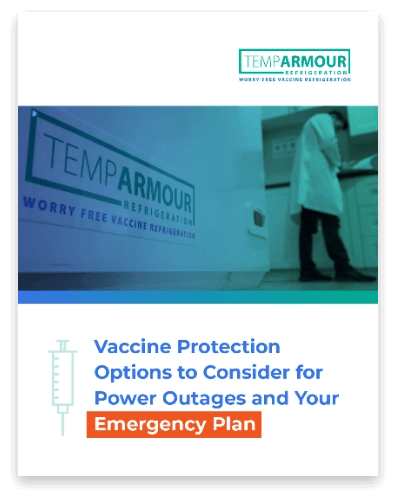 The United States Department of Health's Centers for Disease Control and Prevention (CDC) just released the latest version of its vaccine toolkit. This updated 2020 document lays out the best practices and government recommendations for storing and handling vaccines. It’s an essential set of guidelines for anyone who works with vaccines.Don’t have time to dive into the full document at the moment? Don’t worry. We’ve got you covered. Here are the must-know items from the 2020 CDC Vaccine Storage and Handling Toolkit:
The United States Department of Health's Centers for Disease Control and Prevention (CDC) just released the latest version of its vaccine toolkit. This updated 2020 document lays out the best practices and government recommendations for storing and handling vaccines. It’s an essential set of guidelines for anyone who works with vaccines.Don’t have time to dive into the full document at the moment? Don’t worry. We’ve got you covered. Here are the must-know items from the 2020 CDC Vaccine Storage and Handling Toolkit:
Want to know the differences between the 2019 and 2020 toolkit? Click here.
1. The 2020 CDC Vaccine Storage and Handling Toolkit’s Goal: Keep the Vaccine Cold Chain Unbroken
Overall, the CDC Vaccine Storage and Handling Toolkit is built around one central goal: keeping vaccines effective and safe from the time vaccine is delivered to the provider’s facility (whether it be a distribution point, hospital, or clinic) until the time the vaccine is administered to the patient. This requires taking the appropriate steps to ensure that the vaccine cold chain is unbroken and vaccines aren’t compromised.
If that cold chain is broken at any point during their journey, it could result in a loss of potency or completely destroyed vaccines. The key to avoiding cold chain incidents and protecting vaccines? The CDC points out the following important safeguards:
- Trained staff
- Reliable vaccine storage units and temperature-monitoring equipment
- An accurate vaccine inventory management process
- Effective vaccine transport and emergency handling
2. Setting up Staff and Training Essentials
The vaccine toolkit has laid out some important steps for using staff and training to keep vaccines safe.
First, start by writing out clear standard operating procedures (SOPs) for handling and storing vaccines. By setting expectations, you can get the whole team on the same page. Make sure you set up SOPs to cover three essential areas:
- General info
- Everyday handling and storage
- Emergency handling, storage, and transport
Still, SOPs aren’t much good if employees aren’t familiar with them. This is why the CDC also recommends training personnel to properly store and move vaccines.
Finally, designate a vaccine coordinator. This person will act as the vaccine management expert and will be the resident leader for all vaccine storage and handling.
Note: Providers that are a part of the Vaccines for Children (VFC) or other federally funded program should contact their immunization program for the specific requirements that they must follow.
3. How to Maintain Proper Storage and Temperature Monitoring
Keeping the cold chain intact through every possible circumstance may seem like a daunting task. Luckily, the right equipment can make the job easier. Here are some key equipment highlights from the 2020 CDC Vaccine Storage and Handling Toolkit:
Choose a reliable vaccine refrigerator – Although the CDC notes that it’s possible to store vaccines under the right conditions in household-grade fridges, the toolkit suggests using a purpose-built refrigerator. These professional units are designed to keep vaccines in the appropriate temperature range.
Note: Some purpose-built refrigerator options even provide advantages, such as eliminating freezing and cold spots without the aid of water bottles.
Use a temperature monitoring device (TMD) – It’s easy to assume that a simple thermometer will do the job, but the CDC recommends using a digital data logger (DDL). These devices don’t just tell you the highest or lowest temperature within your unit. Instead, they give you a detailed record of temperature ranges.
4. Inventory Management and Preparation
The toolkit provides several tips on inventory management and vaccine prep. Here are some key pieces to watch for as you’re keeping track of your vaccine supplies:
Stock counts – Of course, if you’re managing inventory, then you need to know what you have in stock and how much of it is available. These counts need to stay current so that your team isn’t left empty-handed or burdened with too much medicine sitting on the shelf with the risk of expiring.
Vaccine ordering – Ordering should line up with patient needs. This way you minimize costly vaccine expirations but have quantities on hand to treat patients.
Stock rotation and removal – Remember to rotate vaccines and review vials for expired doses. If you find an expired vaccine, dispose of it as outlined in Section Four of the Toolkit in order to avoid accidentally using it.
The toolkit also draws special attention to pre-administration preparation, which is the final link in the cold chain. Essentially, it emphasizes that you shouldn’t draw up vaccines until you’re ready to administer them. Vaccines are hard to tell apart when they’re out of their packaging. This means that if they aren’t going directly into someone’s body, they should stay in their labeled container.
5. Vaccine Transportation and Emergency Handling
Of course, the easiest way to transport vaccines is to have them shipped to a facility that has a pharmaceutical-grade storage unit on site. However, that’s not always possible. If there’s a power outage, natural disaster, emergency, or if you need to simply transport vaccines off-site, the toolkit emphasizes preparing in advance. Here are some tips the toolkit points out to keep your vaccines safe during an emergency:
- Set up an alternative storage facility as a backup.
- Make sure you have access to your building, SOPs, and emergency supplies during after hours.
- Be sure you have a temperature monitoring unit in place that works during a power outage.
If the power goes out, the CDC also suggests keeping the storage unit door closed until power is restored.
What’s Different From Last Year?
The January 2020 update of the CDC Vaccine Storage and Handling Toolkit only consists of a few relatively minor changes:
Section Three: Vaccine Storage and Temperature Monitoring Equipment (Page 11)
The following was added to the last section on the page, after “Check and record storage unit minimum and maximum temperatures at the start of each workday.”
Added: ”If your TMD does not read min/max temperatures, then check and record the current temperature a minimum of 2 times per workday (at the start and end of the workday).”
Section Three: Vaccine Storage and Temperature Monitoring Equipment (Page 14)
In the section on conducting routine maintenance for all vaccine storage units, “Defrost manual-defrost freezers” was updated to:
New: “Defrost manual-defrost freezers when the frost exceeds either 1 cm or the manufacturer’s suggested limit. Follow the manufacturer’s instructions. While defrosting, store vaccines temporarily in another unit with appropriate freezer temperatures.”
Section Four: Vaccine Inventory Management (Page 18)
Added to the section on Beyond Use Dates (BUD):
New: “If the vaccine has no BUD, use the expiration date provided by the manufacturer.”
Glossary:
“Portable Vaccine Storage Unit” has been added to the Glossary.
Portable Vaccine Storage Unit A type of powered refrigerator or freezer unit specifically designed for use during vaccine transport. These are passive units that require a power source to function. Please note that some active units are “qualified” to maintain desired temperatures for a set amount of time in the event of a power loss.
Qualified container and packout has been updated to include: "They are passive containers that do not require a power source"
Stay Tuned in to the Latest in Vaccine Storage
Overall, reviewing these tips from the 2020 CDC Vaccine Storage and Handling Toolkit in detail should help you minimize your risk of vaccine losses. TempArmour has more resources to keep you current. Subscribe to our blog today to get the latest updates on vaccine storage, transport, and emergency preparedness including industry best practices, and cutting-edge technology.


